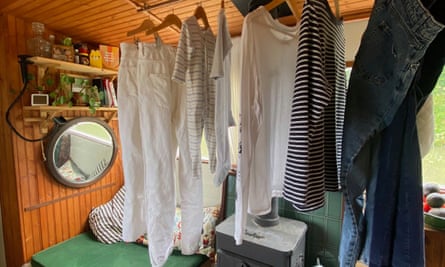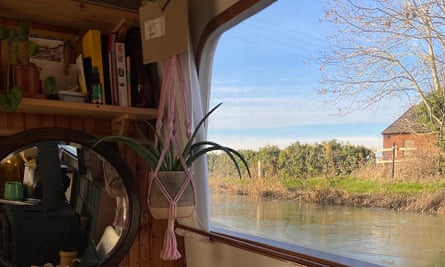
David Westwood moved into a tiny home because traditional housing was too expensive. He says he and his partner were “working full-time and the weeks, months, years were just going by. All of our money was going on bills and we were, like so many others, stuck in the same monotonous cycle of work, work, work.”
The couple had been on the lookout for narrowboats and caravans when they found a company that builds tiny houses and “just kind of decided that’s what we wanted to do”.
David is not the only one moving away from the traditional two-up two-down – in January, the Office for National Statistics revealed that the number of households living in caravans or other temporary or mobile structures in England and Wales has increased by 19,000 in the past decade.
 View image in fullscreenDon’t let stuff pile up: regular decluttering is key to keeping your small space liveable. Illustration: SPENCER WILSON/The Guardian
View image in fullscreenDon’t let stuff pile up: regular decluttering is key to keeping your small space liveable. Illustration: SPENCER WILSON/The Guardian
Whether out of a desire to downsize or due to the strain of the housing crisis, the tiny home movement has been picking up steam in the UK. Self-storage businesses are booming as people find that leaving their possessions in an anonymous box off a ring road is more affordable than living in a house big enough to accommodate them. It is a depressing symptom of a country in desperate need of more affordable housing.
Some will see nothing worth celebrating about downsizing to a tiny home. But for others, such as Westwood, living the tiny life can open up time for family, leave you feeling lighter for a lack of possessions and mean you never have more than a couple of dishes to wash up. Two-and-a-half years on from moving into his £46,000 tiny home on wheels, he says even if house prices dropped by 50%, “we’d stay tiny”.
So, what wisdom can tiny home dwellers share about how to live well in a small space?
Decluttering
Don’t underestimate the amount of stuff you have – and how difficult it may be to get rid of it. Westwood and his family had been “minimising” their lives for two years before making the decision to buy their 5.4 metre x 2.4 metre (18ft x 8ft) home. Similarly, it took Beck Wood “a lot of processing, mentally and physically” to declutter before moving from a London flat into her 12 metre x 2.4 metre barge in 2016. “You definitely have to find a day when your energy feels more brutal than others,” she says.
Clara Moore, a decluttering expert, says to think of your home as a container and then “it’s about having the right amount of stuff for your container”. Too much stuff for your space and “you’re just going to do what’s called ‘churning’… moving stuff from place to place, having a sense of overwhelm. You’re never going to feel on top of what you have within that space”.
Rachel Burditt, AKA the Decluttering Darling, says: “I’d absolutely start with anything that’s broken, worn out or unable to be used by someone else. These items need to leave your home.” Think about how many of something you actually need, advises Moore. “I’m only ever entertaining two or three people at a time, for instance, so I have four cups.”
The decluttering doesn’t end when you move in, either. Wood, who is lead designer at a tiny homes company based in Dorset, is approaching her son’s toys like a nightclub bouncer. “He is now going from newborn to baby and I’m already thinking I need to get rid of these toys to make way for new toys – it’s a one in, one out process.” Moore recommends a seasonal declutter as a great way to keep on top of things.
 View image in fullscreenBeck Wood makes use of all available space on her barge by hanging clothes from the ceiling.
View image in fullscreenBeck Wood makes use of all available space on her barge by hanging clothes from the ceiling.
With the belongings you decide to keep, get smart with how to store them, says Moore. “It’s all the old adages: a place for everything and everything in its place.” She recommends having things “close to purpose”, gathered into categories and stored “in a way that makes sense to your living space and you”. The kitchen may not be traditionally thought of as a tech zone, for instance, but “if you habitually use your tech in the kitchen because you have a wee sitting nook, then store your tech in the kitchen”.
Given floor space will be tight, Burditt recommends utilising vertical storage “such as shelving, bunk beds, peg boards on walls”. If you can’t go high, she suggests you “go low”. She says: “There are so many low and flat storage options to make use of that space.” Look for unexpected spots, such as the backs of doors, where you could use canvas shoe holders as extra storage space, for example.
Moore recommends using slimmer hangers in wardrobes and thinking about how you are folding your clothes, adding: “It’s amazing how much more space you have when you fold the Marie Kondo method where things are like little parcels.”
For Westwood, living in a tiny space presents its own antidote to consumerism. He says: “You just don’t have the room for things, which is great … in reality, you don’t need much stuff and you’re better off without it.”
Cooking
First of all, equipment. Annie Mahle, the author of The Tiny Kitchen Cookbook: Strategies and Recipes for Creating Amazing Meals in Small Spaces, says: “Tiny kitchens don’t get to have rice cookers.” She would know – she spent more than 20 years cooking on a small boat. “Anything that we bring into our tiny spaces has to have more than one purpose. It cannot be a mono-tool.” She lists the essentials as: “One chef’s knife, one paring knife, one saucepan, one sauté/frying pan and a cutting board. That’s really all you need to make fabulous food.”
The key to cooking in a tiny space is keeping on top of things. Mahle says: “You need to clean as you go, chop as you go and cook as you go.” In terms of what to make, “the simpler dishes are obviously better”, she says, especially ones where everything can be cooked in one pan.
 View image in fullscreenExperts recommend minimising cooking equipment and choosing multipurpose items, as Wood has done on her barge.
View image in fullscreenExperts recommend minimising cooking equipment and choosing multipurpose items, as Wood has done on her barge.
Wood agrees: “It is about being organised.” She has shelves above her work surface with “all my glass jars with grains and beans … You can basically cook without having to move your feet”.
Because storage space will be tight, Mahle recommends creating a list of what you consider to be the basics and then buying “the smallest amount possible”. Once again, it then becomes about staying on top of things – “when you run out of that thing, it goes on the shopping list immediately”. Whatever you do, she says, “don’t over-purchase”.
Are there any dishes it will be impossible to cook in a small space? I think of the dish that I create the biggest mess making – lasagne. “You can,” says Mahle. But, she adds: “How much effort do you want to put into that dish … does it have to be lasagne or could it be a baked pasta?”
Less easy to work around is the fact that the odour of whatever you cook will waft around the whole of your living space. “Having a well-ventilated tiny house is a good idea,” says Mahle, as is doing what you can to cook particularly smelly things on an outside grill.
Bathing
Westwood says: “I wouldn’t say our bathroom is any different from anyone else’s, except we only have about 1 sq metre to stand in. But it’s all you need.” You might need to make some compromises. Wood has a big Victorian avocado ceramic shower tray, but no sink. They use the sink in the kitchen to wash their hands and clean their teeth.
In terms of lotions and potions, “you couldn’t have endless amounts of things”, says Westwood, “but again, we don’t have much stuff”. It goes back to the decluttering. He used to own a dozen aftershaves but slimlined his collection when he moved in: “I just got rid of them all.” Wood is similarly dogmatic: “I have actually just done another big declutter. Ruthless. I haven’t touched this since last year, why have I even got it?”
Of course, there will be other inconveniences about having a bathroom so close to the rest of the living space. “Palo santo helps with any odour,” says Mahle, referring to the lovely smelling wood you can light for a quick fix.
 View image in fullscreenKeep on top of cleaning, especially if you have pets. Everything looks dirtier in a small space. Illustration: SPENCER WILSON/The Guardian
View image in fullscreenKeep on top of cleaning, especially if you have pets. Everything looks dirtier in a small space. Illustration: SPENCER WILSON/The Guardian
Cleaning
Things will get dirtier quicker in a tiny space, says Westwood. “So you just keep on top of it.” This is especially important if you are sharing your limited square footage with pets. His two small dogs “add to the mess quite a bit and we’re constantly hoovering up dog hair”.
In terms of washing clothes, most tiny homes will be able to accommodate a pretty standard washing machine. But Westwood says that drying laundry “can be a bit of a pain”. They “use a clothes horse year round: in the summer it dries outside and in the winter we put it in the bathroom with a dehumidifier and it dries quite quickly”.
Once dishes are washed, they need to be dried and immediately put away.
Sleeping
Good sleep hygiene would have it that the place where you sleep is quiet, dark and free from the detritus of the day. In a tiny living space, where one area can easily spill into another, it becomes even more important to follow some strict rules when it comes to the bedroom. The section of Wood’s boat with her bed is kept just as “bedland – neat and tidy. No clothes go in there”.
Westwood has a similar tip – by not having much besides the bed in the bedroom, they are able to have a king-size mattress.
 View image in fullscreenBeing organised is vital. Storing items outside the bedroom can help to create a calm space for sleeping. Illustration: SPENCER WILSON/The Guardian
View image in fullscreenBeing organised is vital. Storing items outside the bedroom can help to create a calm space for sleeping. Illustration: SPENCER WILSON/The Guardian
Getting on
From toddlers to teens, there will be different challenges as children grow up. Mahle and her husband raised their two daughters, now in their 20s, on their boat between May and October. They live in Maine, in the north-east of the US, so in the cold winters they retreated to a small house. “I’m not saying it was easy to raise our girls on the boat, but at the same time it’s not easy to raise children,” she says, sagely.
They didn’t have toys, opting instead to make up games and tell stories. But also, they involved the children in whatever it was that they were doing. She says: “If I was making bread, the girls were making bread with me.”
Having the right furniture will help with the practical side of family life. Wood says: “I am constantly adjusting the boat layout to fit my son’s needs and development.” For her, bespoke furniture is vital. “My sofa is made up of three pieces and they can be moved about so it can be a bed, it can be two sofas facing each other, it can be an L-shaped sofa, it can be a sofa and a coffee table.”
When it comes to teenagers’ need for a closed door, that may be a little trickier to facilitate in a tiny space. “We talked about it,” says Mahle, diplomatically. “Sometimes they got [their space] and sometimes they didn’t … But they were heard. I think what teenagers need is to be heard.”
 View image in fullscreenA room with a view … advocates say decluttering and downsizing can lead to a better quality of life. Photograph: Supplied image
View image in fullscreenA room with a view … advocates say decluttering and downsizing can lead to a better quality of life. Photograph: Supplied image
Almost everyone I speak to mentions the tiny home “dance”. Mahle says: “You definitely need to develop some kind of shorthand that becomes an easy understanding of ‘I’m just letting you know that I’m here but it’s cool, you’re not in my way’.” She points to the kind of communication chefs use in a restaurant kitchen, such as saying “behind” when you’re walking behind someone.
Her family shared a cabin and only one person at a time could stand and change their clothes or brush their teeth. It is, she says, about mindset. “Think about it as trying to create a lovely harmony rather than something that’s an annoyance.”
Communication is essential. “Small spaces make it so that you must deal with your emotional wellbeing, individually, so that you can bring your best self to the communication.” There is, she says, no hiding. But while emotional health is important, there are also a few crucial pieces of kit that may help keep the peace. Say one person is working or doing their homework and the other wants to listen to music. Mahle says: “Just put some earbuds in – you’re getting what you want but you’re not impacting on the other person’s need for quiet.” A head torch is handy so that people can get dressed or get to bed in a room where others are asleep, without having to put the light on.
Westwood notes that one of the big things about family life in his tiny home is that they spend a lot more quality time together now, and their outgoings have halved since they moved in. Where work used to take up most of the week, he’s now a stay-at-home dad and they “play Xbox together, have movie nights or go out and play football” instead.

